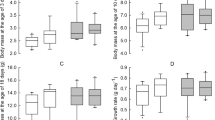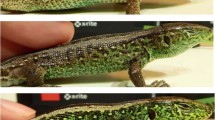Summary
Endotherms living at temperate and arctic latitudes must adjust their physiology and behavior in order to survive seasonal change. The Djungarian hamster uses photoperiod to cue annual cycles of reproduction and thermoregulation, and its responses to short photoperiod include loss of body weight and change in pelage color. Some individuals do not exhibit these responses when exposed to short days.
In this study individual variation in photoresponsiveness is quantified, and four lines of evidence for a genetic component to that variation are provided. First, two separate breeding stocks differed in both the percent of animals responding to a short-day lighting regimen (SD) and in the degree and timing of their response. Second, analysis of variance within and between families of full sibs for a photoresponsive index, PI (body weightloss +2 (molt index −1)) following 12 weeks in SD demonstrated a significant family resemblance (intraclass correlation of 0.36±0.03). Third, heritability estimates from regression of offspring scores on parent scores for body weight loss, molt index and PI after 12 weeks in SD were 0.34∓0.13, 0.36±0.10 and 0.37±0.12, respectively, indicating a strong additive genetic component for the three characters. Finally, a significant response occurred after one generation of artificial selection for and against photoresponsiveness.
Similar content being viewed by others
Abbreviations
- PI :
-
photoresponsive index (body weight loss+2 (molt index −1))
- SD :
-
short day light regimen
References
Bronson FH (1985) Mammalian reproduction: an ecological perspective. Biol Reprod 32:1–26
Bronson FH, Marsteller FA (1985) Effect of short-term food deprivation on reproduction in female mice. Biol Reprod 33:660–667
Danilevsky AS (1965) Photoperiodism and seasonal development of insects. Oliver and Boyd, London, pp 283
Darrow JM, Goldman BD (1985) Circadian regulation of pineal melatonin and reproduction in the Djungarian hamster. J Biol Rhythms 1:39–51
Desjardins C, Bronson FH, Blank JL (1986) Genetic selection for reproductive photoresponsiveness in deer mice. Nature 322:172–173
Dingle H, Brown KC, Hegmann JP (1977) The nature of genetic variance influencing photoperiodic diapause in a migrant insectOncopeltus fasciatus. Am Nat 111: 1047–1059
Elliott JA (1976) Circadian rhythms and photoperiodic time measurement in mammals. Fed Proc 35:2339–2346
Elliott JA, Goldman BD (1981) Seasonal reproduction: photoperiodism and biological clocks. In: Adler NT (ed) Neuroendocrinology of reproduction. Plenum, New York, pp 377–426
Falconer DS (1981) Introduction to quantitative genetics. Longman, New York, pp 340
Figala J, Hoffmann K, Goldau G (1973) Zur Jahresperiodik beim Dsungarischen Zwerghamster,Phodopus sungorus Pallas. Oecologia 12:89–118
Fisher RA (1958) The genetical theory of natural selection. Dover New York, pp 291
Heath HW, Lynch GR (1982) Intraspecific differences for melatonin-induced reproductive regression and the seasonal molt inPeromyscus leucopus. Gen Comp Enocrinol 48:289–295
Hecht MK (1952) Natural selection in the lizard genusAristelliger. Evolution 6:112–124
Heldmaier G, Lynch GR (1986) Pineal involvement in thermoregulation and acclimatization. Pineal Res Rev 4:97–139
Heldmaier G, Steinlechner S (1981) Seasonal control of energy requirement for thermoregulation in the Djungarian hamster (Phodopus sungorus) living in natural photoperiod. J Comp Physiol 142:429–437
Heller HC, Musacchia XJ, Wang LCH (1986) Living in the cold. Elsevier, New York, pp 587
Hoffmann K (1973) The influence of photoperiod and melatonin on testes size, body mass, and pelage colour in the Djungarian hamster (Phodopus sungorus). J Comp Physiol 85:267–282
Johnson GB (1974) Enzyme polymorphism and metabolism. Science 184:28–37
Joy J, Mrosovsky N (1985) Synchronization of circannual cycles: a cold spring delays the cycles of thirteen-lined ground squirrels. J Comp Physiol A 156:125–134
Levene H (1953) Genetic equilibrium when more than one ecological niche is available. Am Nat 87:331–333
Lynch GR, Puchalski W (1986) Effects of prolonged short day exposure on thermoregulation in the Djungarian hamster (Phodopus sungorus). In: Heller HC, Musacchia XJ, Wang LCH (eds) Living in the cold. Elsevier, New York, pp 317–322
Lynch GR, Sullivan JK, Heath HW, Tamrakin L (1982) Daily melatonin rhythms in photoperiod sensitive and insensitive white-footed mice (Peromyscus leucopus). In: Reiter RJ (ed) The pineal and its hormones. Liss Press, New York, pp 67–71
Marsteller FA, Lynch CB (1987a) Reproductive responses to variation in temperature and food supply by house mice, I. Mating and pregnancy. Biol Reprod 37:838–843
Marsteller FA, Lynch CB (1987b) Reproductive responses to variation in temperature and food supply by house mice, II. Lactation. Biol Reprod 37:844–850
Mrosovsky N (1980) Circannual cycles in golden-mantled ground squirrels: Experiments with food deprivation and effects of temperature on periodicity. J Comp Physiol 136:355–360
Negus NC, Berger PJ (1977) Experimental triggering of reproduction in a natural population ofMicrotus montanus. Science 196:1230–1231
Nelson RJ (1985) Influence of domestication on photoperiodism in male prairie voles,Microtus ochrogaster. Biol Reprod 33:596–602
Nelson RJ (1987) Photoperiod-nonresponsive morphs: a possible variable in microtine population-density fluctuations. Am Nat 130:350–369
Pengelley ET (1974) Circannual clocks. Academic, New York, pp 523
Pittendrigh CS, Takamura T (1987) Temperature dependence and evolutionary adjustment of critical night length in insect populations. Proc Natl Acad Sci USA 84:7169–7173
Puchalski W, Lynch GR (1986) Evidence for differences in the circadian organization of hamsters exposed to short day photoperiod. J Comp Physiol A 159:7–11
Puchalski W, Lynch GR (1988) Charcterization of circadian function in Djungarian hamsters insensitive to short day photoperiod. J Comp Physiol A 162:309–316
Puchalski W, Kliman RM, Lynch GR (1988) Differential effects of short day pretreatment on melatonin-induced adjustements in Djungarian hamsters. Life Sci 43:1005–1012
Sullivan JK, Lynch GR (1986) Photoperiodic time measurement for activity, torpor, molt and reproduction in mice. Physiol Behav 36:167–174
Reiter RJ (1980) The pineal and its hormones in the control of reproduction in mammals. Endocrine Rev 1:109–131
Wright S (1968) Evolution and genetics of populations, vols 1–4. Univ Chicago, Chicago
Author information
Authors and Affiliations
Rights and permissions
About this article
Cite this article
Lynch, G.R., Lynch, C.B. & Kliman, R.M. Genetic analyses of photoresponsiveness in the Djungarian hamster,Phodopus sungorus . J. Comp. Physiol. 164, 475–481 (1989). https://doi.org/10.1007/BF00610441
Accepted:
Issue Date:
DOI: https://doi.org/10.1007/BF00610441




